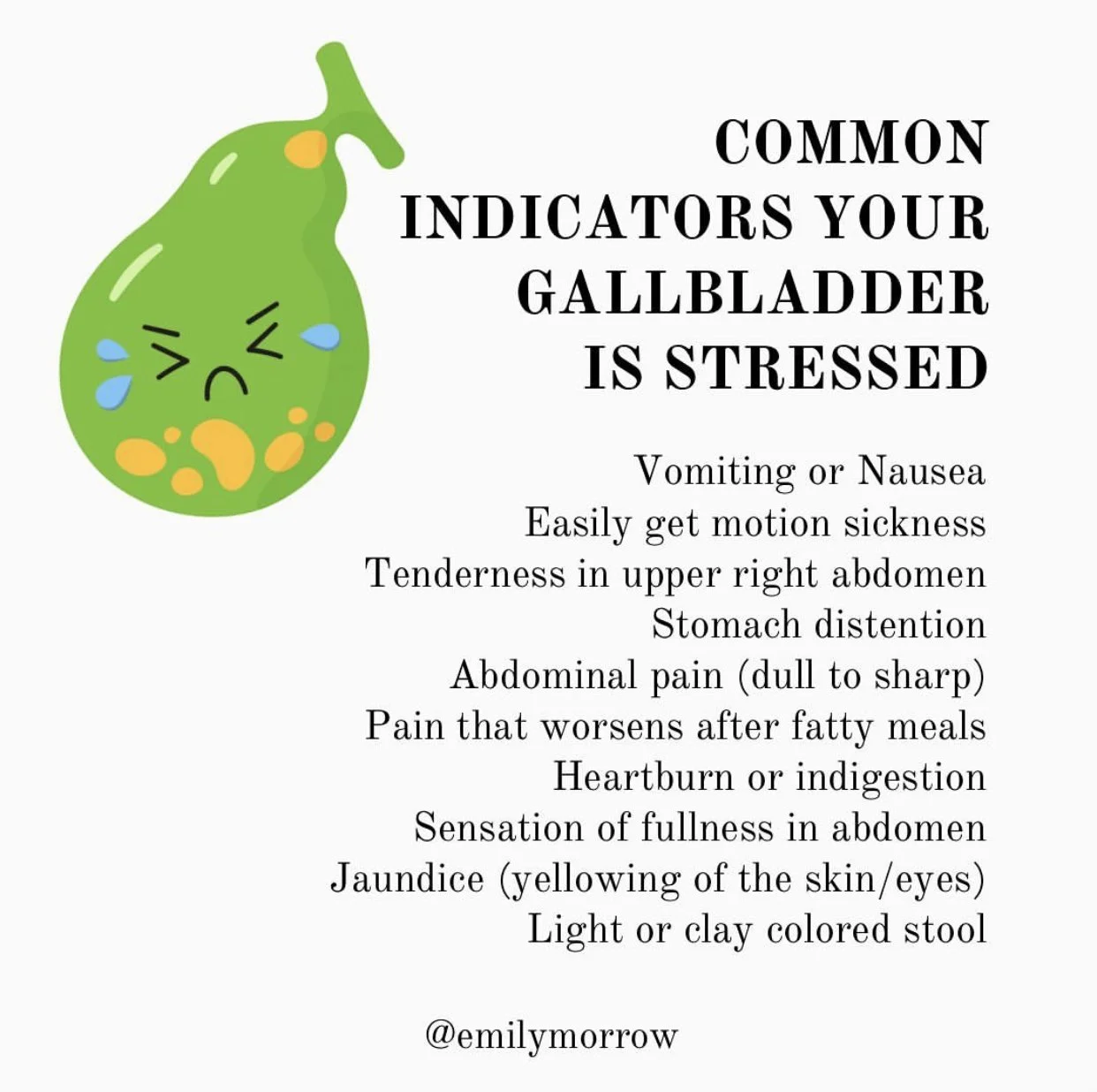The Gallbladder: Roles, Signs of Dysfunction & Support
The gallbladder is the organ that stores bile, the fluid made by the liver that's necessary for digesting and absorbing fat and vitamins and carrying out waste and toxins from the body. It is wild to me how many people I have heard of lately undergoing Cholecystectomy, the surgical removal of the gallbladder and the common “treatment” of symptomatic gallstones and other gallbladder conditions. We must start asking why these surgeries keep increasing by the number and provide some helpful tools and solutions for people.
The Purpose of The Gallbladder
The gallbladder is part of our biliary system, which aids in digesting food. The main function of the gallbladder is to store bile, a liquid made up of water and bile salts that is produced by the liver to help break down fatty meals. As your stomach digests food, the gallbladder releases bile into your small intestine to break down the fat.
Is Your Gallbladder Stressed?
Causes of Gallbladder Issues
It is wild to me how many people I have heard of lately undergoing Cholecystectomy, the surgical removal of the gallbladder and the common “treatment” of symptomatic gallstones and other gallbladder conditions. We must start asking why these surgeries keep increasing by the number and provide some helpful tools and solutions for people.
One one of the most common reasons for gallbladder issues is cholecystitis, the result of hard particles that develop in your gallbladder (gallstones). These stones may form if bile contains too much cholesterol, too much bilirubin, or not enough bile salts. This is most often a result and byproduct of lifestyle and dietary choices.
Processed and fried foods and excess saturated fats or simply not enough healthy fats in the diet can lead to gallstone formation. Cholesterol may be elevated for a number of reasons whether that be liver stress, infections or poor cardiovascular health. Lack of bile salts will also create an issue.. Bile salts are a primary component of bile and are needed by the body to help break down fats, aid digestion, absorb important vitamins, and eliminate toxins. Bile salts are stored in your gallbladder when they're not being used. Bile salts are made up of Choline, Taurine, Glycine and Sea Salt.
Additional factors that may lead to gallbladder issues include:
Hormone Replacement Therapy
“Postmenopausal estrogen therapy, is an important risk factor for gallbladder disease. Observational studies indicate up to a 2.5-fold increased risk of biliary tract conditions related to estrogen therapy.” - Source
Oral Contraceptives
“A meta-analysis of 26 observational studies found a 36% increase in the development of gallbladder disease among women who were using oral contraceptives compared with those not taking these drugs.” - Source
Viral infections can trigger gallbladder inflammation - Source
Parasites residing in the biliary tree dwelling in the bile ducts and gallbladder
“Adult flukes of Clonorchis and Opisthorchis measure 8–15 mm and adult flukes of Fasciola measure 20–40 mm in length. The presence of flukes in the bile ducts causes dilatation of the bile ducts, varying degrees of chronic inflammation followed by adenomatous hyperplasia, and bile duct wall thickening. Imaging findings of clonorchiasis and opisthorchiasis include visualization of adult flukes in the bile ducts and gallbladder, diffuse dilatation of the peripheral small intrahepatic bile ducts with no or minimal dilatation of the large bile ducts, and thickening of the bile duct wall. In biliary fascioliasis and ascariasis, adult worms are visualized in the dilated bile ducts and gallbladder.” - Source
“Ascaris lumbricoides organisms (parasites), which normally reside in the jejunum, are actively motile and can invade the papilla, thus migrating into the bile duct and causing biliary obstruction.” - Source
Tumors
This is the most common and number one reason we see gallbladder issues.
Gallbladder Supports
High quality diet; I love the Mediterranean framework for most people; avoid going too high fat or the low/no fat saga
Exercise— even walking can be beneficial; avoid a sedentary lifestyle
Bile Salt Prouction:
Glycine and Taurine— especially important and crucial for the formation of bile acid
Choline— helps prevent bile from getting thick and sludgy
Taurine— helps increase the production of bile, which works to remove harmful toxins and chemicals; when bile is not regularly being cycled out, one is more prone to conditions like gallstones as well; found in Drainage Essentials
Sea Salt
Gallbladder Supportive Supplements (if you do not have a gallbladder; it is advised to remain on supplemental support ongoing):
TUDCA
Gallbladder ND, Quicksilver
Beta Plus, Biotics
May also need digestive enzymes
Gallstone Support:
Chanca Piedra
Additional Supports
Liver support (see liver blog post) which can free up the gallbladder and help with bile release
Support for root causes that be stressing the body and other organs, such as parasites and viral loads and deficiencies; this is bio-individual based on your own makeup and labs
Vagus nerve support (helps with gallbladder release)
*A Doctor's advice should be sought before using any supplemental dietary product. These statements have not been evaluated by the FDA. These products and educational information is not intended to diagnose, treat, cure or prevent any disease.
A note on supplements: please do not buy just any supplements; please ensure they are good quality, preferably from an online dispensary or specialty grocery store.
Final Notes on The Gallbladder
I highly recommend routine blood work and labs for assessing liver function and working with someone who can personalize a plan for you based on your labs, health history, etc. If you suspect issues, you will want to get a physical exam done. They often use a combination of CT scans and ultrasounds.
References & Further Reading:
Parasitic Diseases of the Biliary Tract
Parasitic Infestations of the Biliary Tract
Oral contraceptives and the risk of gallbladder disease: a comparative safety study
Effect of Estrogen Therapy on Gallbladder Disease
Imaging of the biliary tree: Infection, inflammation and infiltration
Viral Infections of the Biliary Tract











